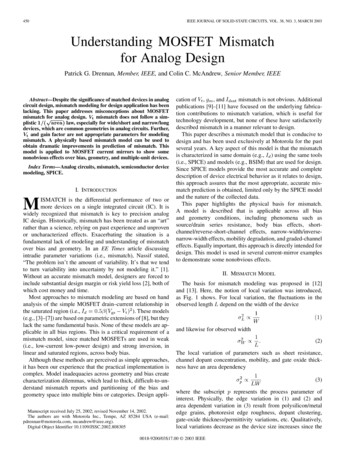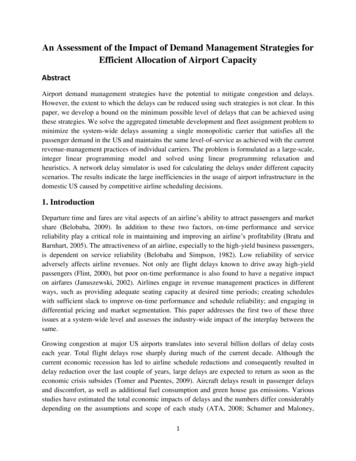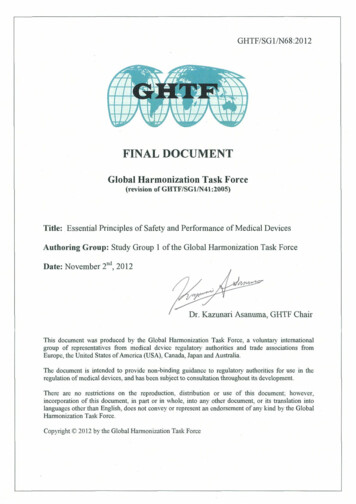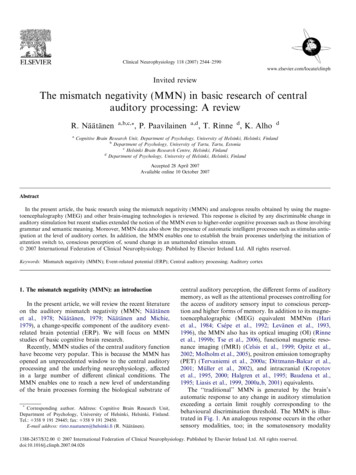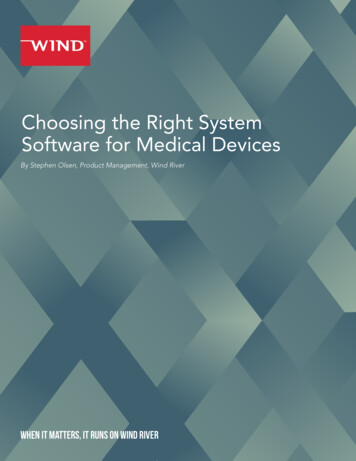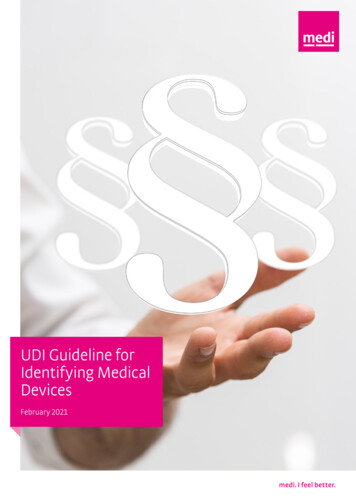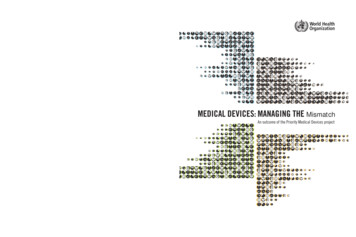
Transcription
MEDICAL DEVICES: MANAGING THE Mismatch An outcome of the Priority Medical Devices projectMEDICAL DEVICES: MANAGING THE MismatchAn outcome of the Priority Medical Devices projectDepartment of Essential Health TechnologiesWorld Health Organization20 Avenue AppiaCH-1211 Geneva 27SwitzerlandTel: 41 22 791 3648E-mail: prioritymeddevices@who.int9 789241 564045
Medical devices: managing the MismatchAn outcome of the Priority Medical Devices project
WHO Library Cataloguing-in-Publication DataMedical devices: managing the mismatch: an outcome of the priority medical devices project.1.Equipment and supplies - standards. 2.Cost of illness. 3.Biomedical engineering. 4.Research. 5.Appropriatetechnology. I.World Health Organization.ISBN 978 92 4 156404 5(NLM classification: WX 147) World Health Organization 2010All rights reserved. Publications of the World Health Organization can be obtained from WHO Press, World HealthOrganization, 20 Avenue Appia, 1211 Geneva 27, Switzerland (tel.: 41 22 791 3264; fax: 41 22 791 4857;e-mail: bookorders@who.int). Requests for permission to reproduce or translate WHO publications – whetherfor sale or for noncommercial distribution – should be addressed to WHO Press, at the above address(fax: 41 22 791 4806; e-mail: permissions@who.int).The designations employed and the presentation of the material in this publication do not imply the expression ofany opinion whatsoever on the part of the World Health Organization concerning the legal status of any country,territory, city or area or of its authorities, or concerning the delimitation of its frontiers or boundaries. Dottedlines on maps represent approximate border lines for which there may not yet be full agreement.The mention of specific companies or of certain manufacturers’ products does not imply that they are endorsedor recommended by the World Health Organization in preference to others of a similar nature that are notmentioned. Errors and omissions excepted, the names of proprietary products are distinguished by initialcapital letters.All reasonable precautions have been taken by the World Health Organization to verify the information containedin this publication. However, the published material is being distributed without warranty of any kind, eitherexpressed or implied. The responsibility for the interpretation and use of the material lies with the reader. In noevent shall the World Health Organization be liable for damages arising from its use.Design & layout: L’IV Com Sàrl, Le Mont-sur-Lausanne, Switzerland.Printed in France.
ContentsAcknowledgementsviiAcronyms and abbreviationsixOverviewxi1. Introduction1.1 Prioritizing medical devices: setting the scene1.2 The Priority Medical Devices project1.3 The mismatch1.4 This report123342. Medical devices2.1 Medical devices: what’s in a name?2.2 Past, present, and future2.2.1 Recent key trends2.2.2 Future trends2.3 Assistive products2.4 Pharmaceuticals and medical devices: similarities and differences2.4.1 Access to essential medicines2.4.2 Access to appropriate medical devices2.5 The medical device market2.6 Medical device regulation2.7 An introduction to medical device innovation2.7.1 Applying non-medical innovation to health care78991011121212141618193. Public health needs3.1 A health-based approach to choosing medical devices3.2 Identifying current and future public health needs3.2.1 Disability3.2.2 Global trends3.3 Public health: the missing research target3.3.1 Drivers of research3.4 The gap2122222526282831An outcome of the Priority Medical Devices projectiii
iv4. Priority Medical Devices project: methods used4.1 Methodology4.1.1 Identifying key medical devices in high-burden diseases4.1.2 Identifying the medical device gap4.2 Results4.2.1 Identifying key medical devices in high-burden diseases4.2.2 Identifying the medical device gaps4.3 Identifying key assistive products for high-burden diseases33343434353539405. Medical devices: problems and possible solutions5.1 Choosing medical devices5.1.1 Barriers to choosing medical devices5.1.2 Possible solutions to overcoming these barriers5.2 Using medical devices5.2.1 Barriers to using medical devices5.2.2 Overcoming barriers to using medical devices5.3 Medical device innovation5.3.1 Barriers to innovation5.3.2 Barriers to appropriate innovation uptake5.3.3 Overcoming the barriers to medical innovation5.4 Assistive devices5.5 Emerging themes5.5.1 Applying the 4 As to medical devices and medical interventions43444450535359616163636566666. Towards appropriate medical devices: options for future research6.1 Methodology6.2 Results6.2.1 Scoping exercise6.3 Future research areas in cross-cutting areas6.3.1 Study design and clinical outcome6.3.2 Laboratory diagnostic tools6.3.3 Telemedicine and labour-saving technologies6.3.4 Safe injections6.4 Future research areas in global high-burden diseases6.4.1 Perinatal conditions6.4.2 Lower respiratory tract infections6.4.3 Unipolar depressive disorders6.4.4 Ischaemic heart disease7778787878787981828484858686Medical Devices: Managing the Mismatch
6.4.5 Cerebrovascular disease (stroke)6.4.6 HIV/AIDS6.4.7 Road traffic accidents6.4.8 Tuberculosis6.4.9 Malaria6.4.10 Chronic obstructive pulmonary disease6.4.11 Cataract6.4.12 Hearing loss6.4.13 Alcohol use disorders6.4.14 Diabetes mellitus6.5 Future trends in high-burden diseases6.5.1 Alzheimer disease and other dementias6.5.2 Cancer (malignant neoplasms)6.5.3 Osteoarthritis6.6 A possible way 03Glossary115Annex 1 List of background papers and methods used in preparing the report1191. A stepwise approach to identifying gaps in medical devices(Availability Matrix and survey methodology)2. Building bridges between diseases, disabilities and assistive devices:linking the GBD, ICF and ISO 99993. Clinical evidence for medical devices: regulatory processes focusingon Europe and the United States of America4. Increasing complexity of medical devices and consequencesfor training and outcome of care5. Context dependency of medical devices6. Barriers to innovation in the field of medical devices7. Trends in medical technology and expected impact on public health8. Future public health needs: commonalities and differencesbetween high- and low-resource settingsAnnex 2 Conflict of interest statement121Annex 3 Steering bodies of the Priority Medical Devices project123An outcome of the Priority Medical Devices projectv
Boxes, figures and tablesBox 2.1Landmarks in medical device developmentBox 2.2Implications of technology trends10Box 2.3The differences in medical devices and pharmaceuticals13Figure 2.1 Medical device markets by region (% sales revenue), 200914Table 2.115Top ten countries by sales revenue, 2009Figure 2.2 World medical markets by sector (% sales revenue), 200915Table 2.2. Top 30 medical device companies by sales revenue, 200816Table 2.3Sales revenue from medical devices in middle-income countries, 200916Box 2.4An historical overview of medical device regulation17Table 2.4Countries with a system for regulating medical devices18Box 3.1The stepwise approach to meeting public health problems22Table 3.1Estimated disability-adjusted life years (DALYs) and years lived with disabilityTable 3.2(YLD) for 15 leading causes of disease burden worldwide, 2004 and 203024DALYs for selected risk factors and high-burden diseases24Figure 3.1 Changing disease patterns across WHO Regions, 2004 and 203027Table 3.3Industry R&D investment by ratio of R&D to sales revenue, 200830Table 4.1Selected clinical guidelines for 15 high-burden diseases35Table 4.2Availability Matrix: example of tuberculosis36Table 4.3Availability Matrix: example of diabetes mellitus37Table 4.4Availability Matrix: example of road traffic accidents38Table 4.5Priority conditions and medical devices identified by countries39Table 4.6Selected high-burden diseases and their associated core sets or functioning profiles41Table 5.1Total health-care expenditure and expenditure on medical technology46Figure 5.1 The hidden costs of medical devices47Figure 5.2 A context pyramid55Table 5.256Medical devices by purpose, place of use and userFigure 5.3 The “valley of death” for innovations62Box 5.1Local innovation leads to increased uptake64Box 5.2Inexpensive innovation in action65Table 5.3Summary of emerging themes relating to the barriers and possible solutionsto access to appropriate medical devicesvi8Medical Devices: Managing the Mismatch67
AcknowledgementsThe Priority Medical Devices project is the result of a collaboration, initiated in 2007, between the Dutch Ministryof Health, Welfare and Sport and the World Health Organization.This publication was produced by the Department of Essential Health Technologies of the Health Systems andServices Cluster under the direction of Josée Hansen.The project was supported by team coordinator Adriana Velazquez Berumen, Björn Fahlgren, Kaarina Klint,Kittie Rasmussen, Dima Samaha, Benjamin Schanker, Frederiek Swart, Gaby Vercauteren and Marieke Veurink.The preparation of this report would not have been possible without the support of the many colleagues at theWorld Health Organization headquarters and regional offices, including Steffen Groth, Director of the Departmentof Essential Health Technologies.Thanks are due to Rhona MacDonald for writing and editing, John Maurice for writing, Dana Wickware forediting, Cathy Needham for copyediting, Kai Lashley for editing advice and proofreading, Rob Hoehn (QuestionPro) for designing the Web survey, L’IV Com Sarl for layout and design, and Sue Hill for reviewing this report.The support and guidance of the following experts, constituting the Steering Group, has been crucial to thedevelopment of the final report: David Banta, Mitchell D. Feldman, Adham Ismail, Carole Longson, Eric A. Mann,Les Olson, and Jeffrey A. Tice.We wish to thank the following people for their contribution to the project: Fernao Beenkens, Pieter Stolk, TheoBougie, Damian Carlson, Olugbenga Oyesanmi, Vivian Coates, Jonathan Gaev, Jenny Dankelman, Frank Painter,Yvonne Heerkens, Warren Kaplan, Annemiek Koster, Hristina Petkova, and Hans Werner.Valuable inputs were received from the participants of Advisory Group meetings and the Informal consultation:Helen Alderson, Robby Bacchus, Joey A.M. Van Boxsel, Jie Chen, Francis Colardyn, Catherine Denis,Catherine Farrell, Lee T. Feldman, Chrystelle Gastaldi-Menager, Christian Hiesse, Maurice Hinsenkamp, SabineHoekstra, Robinah Kaitiritimba, Peter Leeflang, Bert Leufkens, Claude Manelfe, Utz P. Merten, Chiaki Miyoshi,Eoin O’Brien, Frank R. Painter, Agnette P. Peralta, Dulce Maria Martinez Pereira, Norberto Perico, M.S. Pillay,Tim Reed, Mahjoub Bashir Rishi, Michèle Roofe, Greg Shaw, Kunchala M. Shyamprasad, Henk Stam, MarikenStoutmeijer, Per-Gunnar Svensson, Yot Teerawattananon, Ambrose Wasunna, Bart Wijnberg, David Williams,and Wim Wientjens.An outcome of the Priority Medical Devices projectvii
For advice and support we are grateful to: Gerrit van Ark, Sube Banerjee, Arjan van Bergeijk, SaideCalil, Damian Carlson, Rens Damen, Adri Dumay, Renato Garcia, Jan H.B. Geertzen, Robert Geertsma,Michael Gropp, Hilbrand Haak, Hans Hofstraat, Kest Huijsman, Ann Keeling, Marijke de Kleijn - de Vrankrijker,Joy Lawn, Paul de Leeuw, Jan Meertens, Ahmed Meghzifene, Olugbenga Oyesanmi, Vikram Patel, MarkPerkins, Steve Plunkett, Roelf van Run, Frank Ruseler, Bas Streef, Peter Streef, Thijs Teeling, Jürgen Timm,Juan Esteban Valencia Zapata, Rex Widmer, Luc de Witte, and Jean Pierre Zellweger.We would like to thank Gudrun Ingolfsdottir, Divina Maramba and Julia Miraillet for administrative supportthroughout the development of the report.Photographs were provided by Caren Huygelen with the kind support of the following persons and institutionsin the Netherlands: Academisch Medisch Centrum; B.L.M. Zijlmans, N.J. Reus, The Rotterdam Eye Hospital;Medisch Centrum Haaglanden, the Hague; Reinier de Graaf Groep, Delft; Vegro Verpleegartikelen, Katwijk(ZH); Universitair Medisch Centrum, Utrecht. Pictures were also provided by Maternal & Childhealth AdvocacyInternational, United Kingdom, the World Health Organization, Geneva, Switzerland and UNAIDS, Geneva,Switzerland.viiiMedical Devices: Managing the Mismatch
Acronyms and abbreviationsACTArtemesinin Combination TherapyAGREEAppraisal of Guidelines Research and EvaluationAIDSAcquired immunodeficiency syndromeAMESAssisted movement with enhanced sensationBGSMBlood glucose self-monitoringCADTHCanadian Agency for Drugs and Technologies in HealthCENETECNational Center for Health Technology Excellence MexicoCOPDChronic obstructive pulmonary diseaseCORDISEuropean Commission’s Community Research and Development Information ServiceCTComputerized axial tomographyDACEHTADanish Centre for Health Technology AssessmentDALYDisability-adjusted life yearDFGGerman Research FoundationECRIEmergency Care Research InstituteECGElectrocardiogramEUEuropean UnionEWHEngineering World HealthFDAUnited States Food and Drug AdministrationGBDGlobal burden of diseaseGHTFGlobal Harmonization Task ForceGMDNGlobal Medical Device NomenclatureHDIHuman Development IndexHIVHuman immunodeficiency virusHTAHealth technology assessmentHRHHuman resources for healthICDInternational Classification of DiseasesICFInternational Classification of Functioning, Disability and HealthIDFInternational Diabetes FederationIHDIschaemic heart diseaseIECInternational Electrotechnical CommissionIMPACTInternational Medical Products Anti-Counterfeiting TaskforceIMFInternational Monetary FundIOLIntraocular lensISOInternational Organization for StandardizationITUInternational Telecommunication UnionLRTILower respiratory tract infectionMHRAMedicines and Healthcare products Regulatory AgencyAn outcome of the Priority Medical Devices projectix
xMDIMetered dose inhalerMRIMagnetic resonance imagingNCARNational Competent Authority Report programmeNICENational Institute for Health and Clinical ExcellenceNTDNeglected tropical diseasesOECDOrganisation for Economic Co-operation and DevelopmentPATH[see: http://www.path.org for acronym]PETPositron emission tomographyPMDPriority Medical DevicesPPPPublic-private-partnershipR&DResearch and developmentRTARoad Traffic AccidentsSACHSolid ankle cushion heelSBUSwedish Council on health technology Assessment in Health CareSMESmall and medium enterpriseSPECTSingle photon emission computed tomographyTBTuberculosisUGSMUrine glucose self-monitoringUMDNSUniversal Medical Device Nomenclature SystemUNICEFUnited Nations Children’s FundUVUltravioletWHOWorld Health OrganizationYLDYears lived with disabilityMedical Devices: Managing the Mismatch
OverviewMedical devices are important to provide health care and to improve the health of individuals and populations. TheWorld Health Organization (WHO) recognizes this. One of WHO’s strategic objectives is to ensure improved access,quality and use of medical devices. Without medical devices, routine medical procedures—from bandaging a sprainedankle, to diagnosing HIV/AIDS or implanting an artificial hip—would be impossible. Concurrently, modern technologyis producing an overwhelming abundance of medical devices at a rate that soon makes the latest device obsolete.Key issues affecting progress include the extreme diversity of the medical device arena—diverse in terms oftypes of devices, degrees of complexity, applications, usage, users and categories and issues like the contextdependency of medical devices and research in medical devices often not based on public health needs.However, as a crucial component of health care, medical devices will be most effective when considered inthe wider context of the complete health-care package necessary to address public health needs: prevention,clinical care (investigation, diagnosis, treatment and management, follow up, and rehabilitation) and access toappropriate health care. Therefore, rather than just focusing on the technological issues involved in medicaldevices, it is necessary to frame medical devices in another way—as an agenda to improve global accessto appropriate medical devices. This agenda is composed of the crucial “4 As”—Availability, Accessibility,Appropriateness, and Affordability. These four components help to widen the scope of the medical deviceagenda so that it does not just focus on “upstream” innovation efforts but also on choosing which medicaldevices to procure in a rational way, responding to the needs, and in ensuring that they are used as effectivelyas possible to best improve health.A medical device needs to be appropriate for the context or setting in which it is intended. Context in this senserefers to linking the correct medical device with its corresponding health need to maximize its effectiveness.However, almost all devices present in developing countries have been designed for use in industrializedcountries. Up to three quarters of these devices do not function in their new settings and remain unused.Factors contributing to this are: lack of needs assessment, appropriate design, robust infrastructure, spareparts when devices break down, consumables, and a lack of information for procurement and maintenance,as well as trained health-care staff. These issues are part of a broader problem in many countries: the lack ofa medical device management system.Further hampering the situation is the fact that unfortunately, medical device innovation and activities aroundthe choosing and using of medical devices are currently often not based on public health needs.In order to help move forward the agenda to improve global access to appropriate medical devices, the PriorityMedical Devices (PMD) project, convened by WHO, developed a health based approach to medical devices. Thefirst step in this approach was to identify the most important health problems: on a global level this means usingthe global burden of disease and/or disease risk factor estimates (1). The second step was to identify how healthAn outcome of the Priority Medical Devices projectxi
problems are best managed by referring to relevant clinical guidelines. And the third and final step was to linkthe results of the first two steps to produce a list of key medical devices that are needed for the managementof the identified high-burden diseases, at a given health-care level and in a given context.Using this step-wise approach, the PMD project identified the key medical devices involved in the treatmentand management of the global high-burden diseases from relevant clinical guidelines. Of particular note wasthe almost complete absence of any mention of assistive products necessary to help improve functionality ofpeople with these diseases.Further literature searches and qualitative research helped to identify problems and challenges regarding thekey areas in choosing and using medical devices, medical device innovation, and possible solutions to barriers.Medical device innovation is driven largely by the need for better solutions and for greater technologicalcapabilities, and also by promising ideas, scientific interest and economic concerns. In addition, medicaldevice innovation is mainly targeted at high-resource countries. To better align medical device innovation withpublic health needs, increased funding and improved infrastructure is necessary. In addition, better networkingamong stakeholders may help.Choosing a medical device is complex and requires a transparent process based on reason, evidence andassessment of prioritized public health needs. Poor choices lead to inappropriate use or non-use of medicaldevices and a waste of resources. Barriers to rational choosing of a medical device include fascination withtechnology, aggressive marketing, high costs and inadequate information about the device. Possible solutionsinclude improving access to information for decision-making and increasing the role of the biomedical engineeror similar experts.One of the main barriers to optimal use of a medical device is the mismatch between the design of the device andthe context in which it is used. An additional problem is lack of proper device management both at governmentlevel and within health-care facilities. Lack of standardization can also seriously hamper the usability andintegration of devices. Possible solutions include developing designs of medical devices to make them moreappropriate for a specific context, and improved staff training in specific medical device use.This report suggests how an agenda to improve access to appropriate medical devices could be devised fromapplying the crucial 4 components—Availability, Accessibility, Appropriateness, and Affordability, to the 15global high-burden diseases and some cross-cutting issues. The results of this exercise suggest several areasof research necessary to help make medical devices more available, accessible, appropriate, and affordable.Examples include: development of a kit containing simple and affordable technologies for measuring bloodpressure, blood glucose and cholesterol levels, which could assess cardiovascular risk; developing portable,xiiMedical Devices: Managing the Mismatch
affordable spirometry equipment for accurate diagnosis and prognosis of chronic obstructive pulmonary disease(COPD) or asthma in low-resource settings; and the development of more appropriate hearing aids which couldpotentially help people with hearing impairments whatever their age or setting. An example of a key cross-cuttingissue is the need to develop simple, affordable, and reliable sensitivity tests for bacterial and viral antigens.Such tests could replace culture systems to detect the presence of pathogens and effectively and efficientlyhelp to diagnose many high-burden infections and neglected tropical diseases.The PMD project applied the “4 A” questions (Is the medical device: Available? Accessible? Appropriate?Affordable?) to some examples of identified key medical devices to further explore the downstream issuesassociated with poor access to appropriate medical devices.The PMD project hopes all players in the medical device arena can collectively use the findings of this report tohelp make public health a central focus of their activities, along with the work on policies, tools and innovationsof the WHO Global Initiative for Health Technologies (2).11Also see https://www.who.int/medical devices/initiatives/en/, accessed 19 July 2010.An outcome of the Priority Medical Devices projectxiii
Courtesy Royal Picture Gallery Mauritshuis
IntroductionFor several centuries, people, mostly in high-resource settings, have benefited from a hostof discoveries and developments that have improved health. The building of sewage andclean water systems, the discovery of pathogens and antibiotics, and the eradication ofsmallpox are notable examples.In the medical device arena, outstanding developments to date have produced heart-lungmachines and artificial joints, and the means to perform advanced brain surgery, to mentiononly a few examples. Modern medical technology (the application of medical devices) whichdates its origins to the first half of the 19th century, only took off in earnest over the last50 years. Very quickly, medical devices have become an essential part of health care anda vital component of the numerous activities carried out by health-care providers in theirefforts to diagnose and treat people with medical conditions, and to alleviate the problemsfaced by people with functional disabilities.Improvements in the health of many populations are associated with the improved ability topredict, prevent, diagnose and cure many illnesses, and to alleviate functioning problemsusing treatments and technologies that could hardly have been imagined a few decadesago. Among medical products commonly used in health care—such as medicines, vaccinesand medical devices—the most abundant, diverse and widely used are medical devices.Reliable figures are lacking but widely accepted estimates put the number of different maincategories of medical devices available on the world market today somewhere in the regionof 10 000. Adding the vast number of different variants brings the figure to about 90 000with some estimates putting the total as high as 1.5 million (3).Research is making rapid progress within the development of sophisticated medicaltechnologies, such as genetic testing, genetic manipulation of living tissue, robotic surgeryand remote patient management. Yet despite this progress, the majority of the world’spopulation has little or no access to many of these innovations.1
1.1 Prioritizing medical devices:setting the scenewell as strong, flexible wheelchairs for use on unevenroads, high curbs and narrow entrances.Following the global impact of the landmark reportPriority medicines for Europe and the world (4)—whichproposed a specific research agenda leading to thecreation of a public-private-partnership (PPP)—andthe success of the ‘access to essential medicines’agenda in focusing the attention of the internationalcommunity on the specific needs, problems, andchallenges of this crucial public health area, it is nowtime for the international community to focus on anagenda to improve access to appropriate medicaldevices that adequately addresses global publichealth needs. The concept of appropriate medicaldevices is relevant to high-, middle-, or low-incomesettings although each may be viewed from differentends of the spectrum. For example, the abundanceof high-tech, actively marketed medical devicesin high-income settings may mean that medicaldevices are chosen and used based on factors otherthan clinical and public health need. In low-incomesettings, medical devices may be available but notadapted to be effectively used in the local context;for example, they may not withstand hot and dustyclimates or may not run on insufficient electricitysupplies.Low-resource countries often lack the funds andpurchasing power to assess or address their manyvital needs. Industry in high-resource settingstypically has little interest in investing in properneeds assessment and in the required researchand development of medical devices for lowresource countries that promise a low return on thatinvestment (5).Although there are many similarities to the issuesinvolved in prioritizing medicines and the ‘access toessential medicines’ agenda, accessing appropriatemedical devices has its own set of unique problemsand challenges that urgently need solutions. It isimportant to note that although a crucial componentof health care, access to appropriate medical deviceswill be most effective when considered in the widercontext of the complete health-care packagenecessary to address public health needs: prevention,clinical care (investigation, diagnosis, treatment andmanagement, follow-up, and rehabilitation) andaccess to appropriate health care.Priority needs for health care and research can differwidely between high- and low-resource countries.Patients in high-resource countries may have agrowing need for improved drug-releasing (eluting)cardiac stents and labour saving technologies.Patients in low-resource countries may urgentlyneed simple, robust, affordable diagnostic tools, asThese divergent priority needs are amplified by thefact that medical technology readily used in highresource countries is often difficult or impossible touse in low-resource settings for lack of appropriateinfrastructure, inappropriate design, lack ofspecialized human resources, to mention a fewfactors.Medical research priorities in most high-resourcecountries are based primarily on scientific andtechnological preferences, with little explicit regard forpublic health needs (6). In consequence, informationabout medical conditions and diseases does nottranslate into effective management of local healthsystems, nor does it translate into efforts to build thecapability of low-resource countries to conduct anduse research and to become technology innovatorsthemselves.Biomedical research contributes to scientificprogress, to finding solutions to health problems,and to development, equity, global security andthe fight against poverty (7). As with similar healthresearch areas, research relating to medical devicesis not targeting populations in large parts of the world(8). Most research activities focus on the needs of theindustrialized countries.Research pertinent to the needs of developingcountries is “grossly under-resourced in manyareas”, according to the Global Forum on HealthResearch.1 This discrepancy in health researchfunding is captured in the so-called “10/90 gap”,a term coined in 1990 by the Global Forum onHealth Research to highlight the fact that only 10%of global health research expenditure is devoted12Medical Devices: Managing the 90-gap (accessed 17 July 2010).
to conditions that together account for 90% of theglobal disease burden (9). Compounding the issuein many low-resource countries is the tendency formuch of public health research spending—and ofresearch agenda setting—to be concentrated underthe control of academic centres in industrializedcountries. Ideally, health research agendas shouldbe national governments’ responsibility. The PriorityMedical Devices (PMD) project was established tohelp to address these problems.1.2 The Priority Medical DevicesprojectIn May 2007, the Sixtieth World Health Assemblyexpressed concern about the waste of resourcesresulting from inappropriate investments in healthtechnologies—in particular, medical devices thatdo not meet high-priority needs, are incompatiblewith existing infrastructures, are irrationally orincorrectly used, or do not function efficiently.The World Health Assembly adopted resolutionWHA60.29 and acknowledged the need “to containburgeoning costs by establishing priorities in theselection and acquisition of health technologies on the basis of their impact on the burden ofdisease,
Top 30 medical device companies by sales revenue, 2008 16 Table 2.3 Sales revenue from medical devices in middle-income countries, 2009 16 Box 2.4 An historical overview of medical device regulation 17 Table 2.4 Countries with a system for regulating medical devices 18 Box 3.1 The stepwise approach to meeting public health problems 22 .


